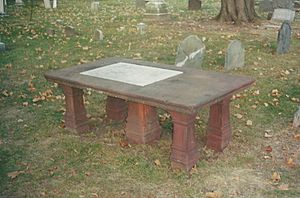Thomas Fitch (governor) facts for kids
Quick facts for kids
Thomas Fitch IV
|
|
|---|---|

The table tomb of Thomas Fitch in East Norwalk Cemetery
|
|
| 29th colonial governor of Connecticut | |
| In office 1754–1766 |
|
| Preceded by | Roger Wolcott |
| Succeeded by | William Pitkin |
| Member of the House of Representatives of the Connecticut Colony representing Norwalk |
|
| In office May 1726 – October 1726 Serving with James Lockwood
|
|
| Preceded by | Joseph Platt, Samuel Comstock |
| Succeeded by | Joseph Platt,< Samuel Comstock |
| In office May 1727 – October 1727 Serving with James Lockwood
|
|
| Preceded by | Joseph Platt, Samuel Comstock |
| Succeeded by | Joseph Platt, Samuel Comstock |
| In office May 1729 – October 1729 Serving with James Lockwood
|
|
| Preceded by | Joseph Platt, Samuel Comstock |
| Succeeded by | Joseph Platt, Samuel Comstock |
| In office May 1730 – October 1730 Serving with Joseph Birchard
|
|
| Preceded by | Joseph Platt, Samuel Comstock |
| Succeeded by | Joseph Platt, Samuel Comstock |
| Member of the Connecticut General Assembly Council of Assistants | |
| In office 1734–1746 |
|
| Personal details | |
| Born | c. 1699 Norwalk, Connecticut Colony |
| Died | July 18, 1774 Norwalk, Connecticut Colony |
| Resting place | East Norwalk Historical Cemetery, Norwalk, Connecticut |
| Alma mater | Yale College |
| Profession | lawyer |
Thomas Fitch IV (born around 1699, died July 18, 1774) was an important leader in the early history of Connecticut. He served as the governor of the Connecticut Colony from 1754 to 1766. This was a time when Connecticut was still a colony ruled by Great Britain.
Early Life and Public Service
Thomas Fitch IV was born in Norwalk, Connecticut. His father, Thomas Fitch III, was an investor in land. Thomas Fitch IV went to Yale College and graduated in 1721. He also earned a master's degree.
In 1724, he married Hannah Hall. They had several children together. Their first child, Thomas Fitch V, was born in 1725.
Thomas Fitch IV held many important jobs in Connecticut. He was a Justice of the Peace in Norwalk. He also served in the Connecticut General Assembly. Later, he became the Chief Justice of the Connecticut Superior Court. His most important role was serving as the Governor of the Colony of Connecticut.
He passed away on July 18, 1774. He is buried in the East Norwalk Historical Cemetery in Norwalk.
The Historic Fitch House
The home where the Fitch family lived was partly destroyed during a British attack in July 1779. This event is known as the "burning of Norwalk." Only one part of the house was left standing after the attack.
Fitch's family members continued to live in the rebuilt house until 1945. In 1956, the house was moved to a new spot. This was done to make room for the building of the Connecticut Turnpike. Today, the Fitch house is part of the Mill Hill Historic Park in Norwalk. It stands next to the Green.
Lasting Legacy and Family Impact
Many places and things are named after the Fitch family, including Thomas Fitch IV.
- Fitch Street: This street in East Norwalk is named for the family. It honors Thomas Fitch I, who helped found the town. It also honors Governor Thomas Fitch IV and his son, Thomas Fitch V.
- Thomas Fitch V: The governor's son, Colonel Thomas Fitch V (1725–1795), was a soldier. He fought with British colonial troops in the French and Indian Wars in New York. After the war, he returned to Norwalk. He was a key person in the town during and after the American Revolution. He helped rebuild Norwalk after it was burned in 1779.
- Thomas Fitch School: A former school in Norwalk was named in honor of Governor Fitch. It also honored the other Thomas Fitches who helped the town.
- Fitchville, Ohio: This area in Ohio is named after the governor and his family. It is located in a historic area called the Firelands.

